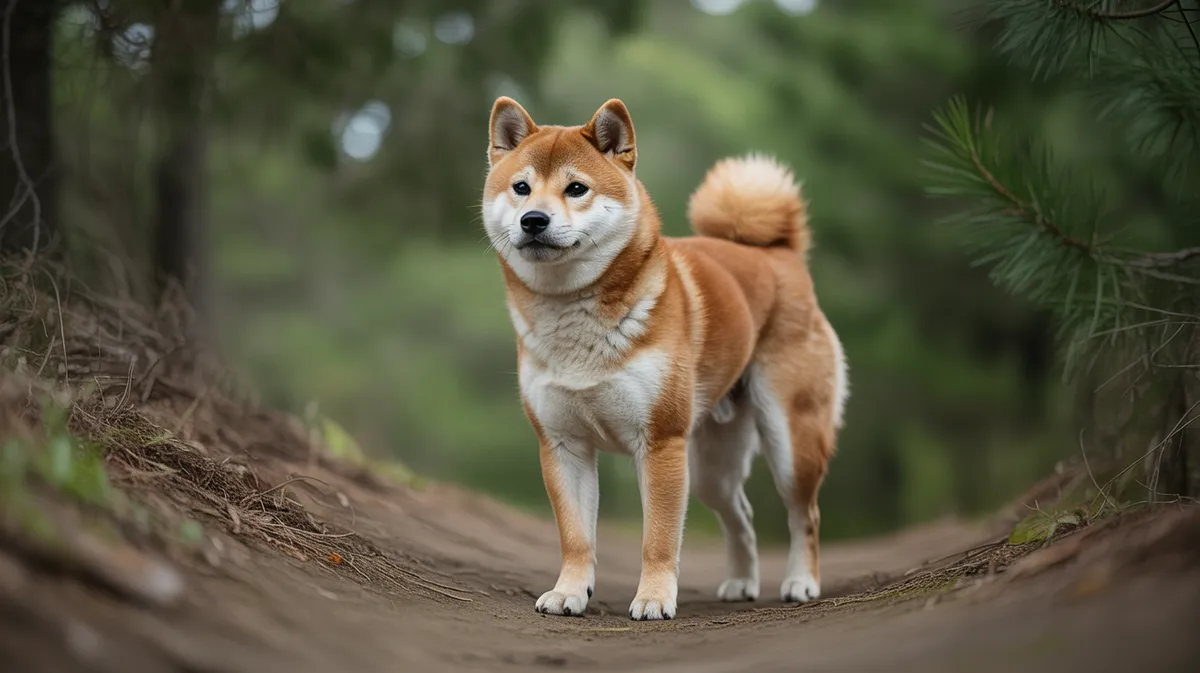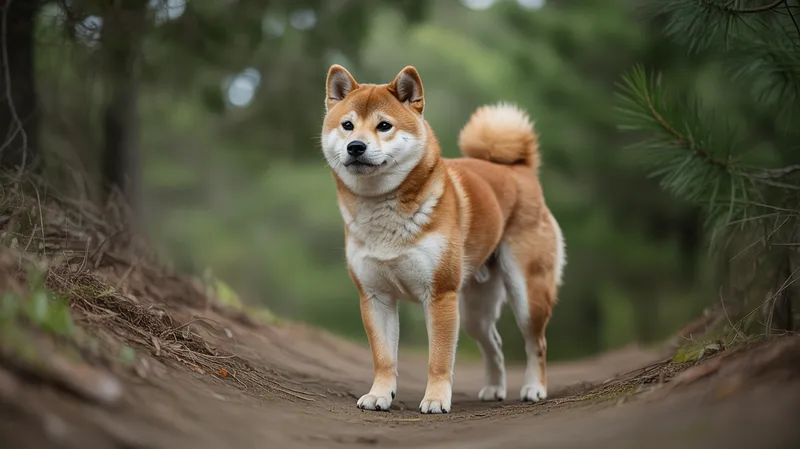
Shiba Inu
Canis lupus familiaris

Meet the Shiba Inu
The Shiba Inu is a small, agile dog breed native to Japan, originally bred for hunting small game in mountainous terrain. Recognized for its fox-like appearance, curled tail, and spirited personality, the Shiba Inu is one of the oldest and smallest of the native Japanese dog breeds. Shibas are known for their independence, intelligence, and cleanliness, often compared to feline behavior. They are highly alert, making them excellent watchdogs, and their adaptability allows them to thrive both in urban and rural environments.
Classification
Mammal
Habitat
Domesticated; originally mountainous and forested regions of Japan
Diet
Omnivore
Lifespan
12-16 years
Conservation
Least Concern
Weight
7-11 kg (15-24 lbs)
📖Fascinating Facts
Fox-like Appearance
Shiba Inus are often mistaken for foxes due to their pointed ears, curled tails, and reddish coat.
Japanese Heritage
The breed is one of six native Japanese dog breeds and has been declared a national treasure in Japan.
Unique Vocalization
The 'Shiba scream' is a distinctive, piercing sound made when the dog is excited or unhappy.
📋Detailed Description
The Shiba Inu is a compact, well-muscled dog breed characterized by its fox-like face, erect triangular ears, and a distinctive curled tail that rests over its back. Adult males typically weigh around 10 kg and stand 35–43 cm at the withers, while females are slightly smaller at 8 kg and 33–41 cm tall. The breed possesses a dense double coat, with a stiff, straight outer layer and a soft, insulating undercoat, providing protection against harsh weather—an adaptation to its mountainous origins. Shiba Inus display a confident, spirited demeanor, often described as 'bold yet good-natured.' Their almond-shaped eyes and keen expression reflect high intelligence and alertness. Anatomically, they have strong, agile limbs suited for quick bursts of speed and maneuverability, essential for flushing small game in dense underbrush. Socially, Shibas are independent but form strong bonds with their families, displaying loyalty while maintaining a degree of aloofness with strangers. They are known for their fastidious grooming habits, often likened to those of cats, and their vocalizations include the unique 'Shiba scream'—a high-pitched yelp emitted when excited or distressed. Reproductively, Shibas have moderate litter sizes, averaging three puppies, and demonstrate attentive maternal care. Their longevity is notable, with many individuals living 12–16 years, and some reaching up to 18 years with proper care.
💡 Did you know?
The Shiba Inu is the most popular companion dog breed in Japan and has become a global internet sensation thanks to their expressive faces and memes.
🔬Research & Sources
Wikipedia Summary
The Shiba Inu is a breed of hunting dog from Japan. A small-to-medium breed, it is the smallest of the six original dog breeds native to Japan. The Shiba Inu was originally bred for hunting. Its name literally translates to "brushwood dog", as it is used to flush game.
Last Modified: 6/6/2025
🎭Behavior & Social Structure
Shiba Inus are highly alert and responsive, exhibiting a blend of independence and curiosity. Historically bred for hunting, they retain a strong prey drive, often chasing small animals and displaying keen tracking abilities. Their feeding behavior is typical of domestic dogs, but they may show food selectivity and are known for their clean eating habits. Social interactions are characterized by a reserved approach to unfamiliar people and animals, but they are affectionate and playful with familiar individuals. Shibas are territorial and may be assertive with other dogs, particularly of the same sex. Daily routines include periods of high activity interspersed with rest; they benefit from regular exercise and mental stimulation. Play behavior is robust, involving chasing, pouncing, and tugging. Shibas are also noted for their vocalizations, which include barks, growls, and the distinctive 'Shiba scream.' They are generally fastidious, often grooming themselves and avoiding soiling their living spaces.
👶Reproduction & Life Cycle
Shiba Inus reach sexual maturity between 6 and 12 months of age, though responsible breeding is typically delayed until 18–24 months to ensure physical and behavioral maturity. The breed is monoestrous, with females coming into estrus (heat) approximately twice a year. Mating is usually preceded by courtship behaviors such as sniffing, licking, and play. Gestation lasts about 63 days, after which the female gives birth to an average of three puppies, though litters can range from one to five. Neonates are altricial, requiring extensive maternal care, including nursing, grooming, and thermoregulation. Weaning occurs at 6–8 weeks, with socialization and early training beginning during this period. Both parents may participate in socializing the puppies, though the female provides the majority of direct care.
🛡️Adaptations & Survival
The Shiba Inu's compact, muscular build and agile limbs are evolutionary adaptations for navigating rugged, mountainous terrain and dense brush. Their double coat insulates against cold and repels moisture, while the curled tail provides warmth when curled over the nose during rest. Acute senses of hearing and smell enhance their hunting capabilities, enabling them to detect and flush small game. Behaviorally, their independence and intelligence are advantageous for solitary hunting and problem-solving. Fastidious grooming reduces parasite load and maintains coat health. Their reserved, alert nature makes them effective watchdogs, while adaptability allows them to thrive in both rural and urban environments.
🎨Cultural Significance
The Shiba Inu holds a prominent place in Japanese culture as one of the country's six native dog breeds, recognized as a national treasure. Historically, Shibas were valued for their hunting prowess, particularly in flushing birds and small mammals from brushwood. In modern times, they are celebrated for their spirited personality and have become cultural icons, featured in art, literature, and popular media. The breed symbolizes loyalty, agility, and resilience, and is often associated with good fortune. The Shiba Inu's image has achieved global recognition, notably as the face of internet memes and as the mascot for various brands and cryptocurrencies.
🔬Recent Research & Discoveries
Recent genetic studies have confirmed the Shiba Inu's ancient lineage, with mitochondrial DNA analyses indicating divergence from other East Asian breeds thousands of years ago. Ongoing research focuses on breed-specific health issues, such as genetic markers for autoimmune diseases and joint disorders. Behavioral studies have examined the breed's independence and trainability, highlighting the importance of early socialization to prevent fear-based aggression. Conservation genetics projects in Japan aim to preserve traditional bloodlines and prevent genetic bottlenecks. The Shiba Inu has also been included in comparative studies of canine cognition, demonstrating problem-solving skills and unique communication behaviors.
🎥Wildlife Videos

Mischievous Shiba Inu Pup Gets Her Sisters In On The Fun! | Too Cute!
Mischievous Shiba Inu puppy Cinnamon is always getting into trouble, and she won't give up on getting her two sisters involved in ...
Animal Planet

Lost Shiba Inu's Incredible Jungle Survival & Emotional Rescue
Welcome to HeartPaw Diaries, your hub for heartwarming wildlife rescue stories, Arctic exploration, and nature conservation.
HeartPaw Diaries

A Shiba Inu's AMAZING Rescue Effort Saves a Trapped Horse from Mud
Welcome to White Wilderness, where we bring you the most heartbreaking, inspiring, and visually stunning stories of Arctic wildlife ...
White Wildeness

Lovely Animal Sounds: Shiba Inu, Raccoon, Bat, Hippo,... | Animal Moments
Lovely Animal Sounds: Shiba Inu, Raccoon, Bat, Hippo,... | Animal Moments https://youtu.be/pIlMnUOrsUM As we all know, ...
Relaxing Nature In 4K

Shiba Inu vs Monkey in Japan | Wild Japan | BBC Earth
Japanese farmers have been using the internet's favourite dog to pretect their crops from thieving monkeys! Subscribe to BBC ...
BBC Earth
🌍Habitat Information
The Shiba Inu typically inhabits Domesticated; originally mountainous and forested regions of Japan environments. Shiba Inus have adapted to their environments with specialized features and behaviors.
Primary Habitat:
Domesticated; originally mountainous and forested regions of Japan
More detailed habitat information will be available soon.
🛡️Conservation Status
The Shiba Inu is currently classified as Least Concern. Conservation efforts are crucial for preserving this species for future generations.
Common Threats:
- 🏠Habitat loss and fragmentation
- 🌡️Climate change impacts
- 🎯Hunting and poaching
- 🏭Human-wildlife conflict
⚠️Threats & Conservation Challenges
As a domesticated breed, Shiba Inus are not threatened in the wild, but they face challenges related to genetic health issues, such as patellar luxation, hip dysplasia, and certain autoimmune disorders. Unscrupulous breeding practices can exacerbate these problems. Population trends are stable or increasing globally, but the breed's popularity has led to overbreeding and potential behavioral issues in poorly socialized individuals. In Japan, preservation of the breed's genetic integrity is a concern, with efforts to maintain traditional lines. Human impact is generally positive, though abandonment and lack of proper training can lead to welfare issues.
🔬Scientific Classification
Scientific Name
Canis lupus familiaris
Classification Hierarchy
🔍 About Taxonomic Classification
Taxonomic classification is a hierarchical system used by scientists to classify and organize living organisms based on shared characteristics and evolutionary relationships.
The system moves from broad categories (Kingdom) to increasingly specific ones, with each animal's scientific name typically consisting of its Genus and species.
📝Community Notes
Share your observations and insights about the Shiba Inu with our community of wildlife enthusiasts.
Join Our Community
Sign in to share your observations and connect with fellow wildlife enthusiasts.
Sign In to ContributeNo community notes yet
Be the first to share your observations about the Shiba Inu!
Explore Shiba Inu
Select a tab above to learn more about this amazing animal.
📸Photo Gallery
No photos available for this animal yet.
🌟Discover More Wildlife
Continue your journey of discovery with more fascinating animals from our database
